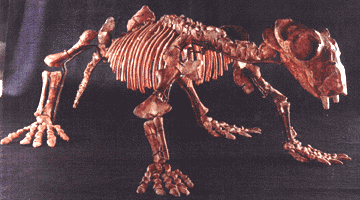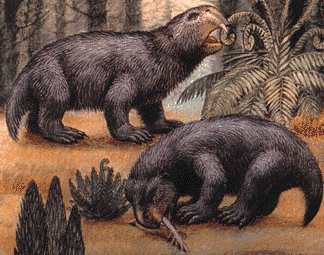
Lystrosaurus georgi -Kalandadze, 1975- skeleton
Therapsida:
Anomodontia: Lystrosauridae
Locality: Astashikha, Vetluga
River, Nizhegorodskaya Region, central European Russia
Age: Early Triassic, 240
million years ago
Meaning of name: "shovel reptile"
Size: small dog
On
the boundary between the Permian and Triassic Periods
approximately 230 million
years ago, the drying of climate caused essential
changes to the land environment
in both Laurasia and Gondwana.
Many groups of the Paleozoic terrestrial vertebrates
became extinct.
However some dicynodonts adapted to modified conditions and spread
very widely.
Lystrosaurus is known from many parts of the ancient megacontinent
Gondwana.
It is known, for example, in Antarctica, India, and Africa.
In recent
decades it has been found in Russia, China and Mongolia.
This
may be the result of movement of animals from Gondwana
across the large land mass
of northern and southern continents
combined, Pangaea, at the time Lystrosaurus
lived.
Historically,however, the geographic distribution of Lystrosaurus
and
a number of other animals and plants were used as
evidence of the past existence
of Gondwana.
As in another mammal-like reptile Dicynodon,
the
teeth of Lystrosaurus were reduced to a pair of tusks.
Both of these reptiles
appear to have been herbivores.
The structure of the skull, with the nostrils
and eye sockets
placed near the top of the head, the snout turned down at the
tip and the
teeth and jaws placed low, all suggest that Lystrosaurus was an amphibious
feeder,
in much the same fashion as the living hippopotamus.
Lystrosaurus dwelt in coastal
environments of the rare continental basins,
where they dug up plant roots with
their teeth.
Their wide paws permitted them to walk in the most boggy places
when
searching for delicate forage.






